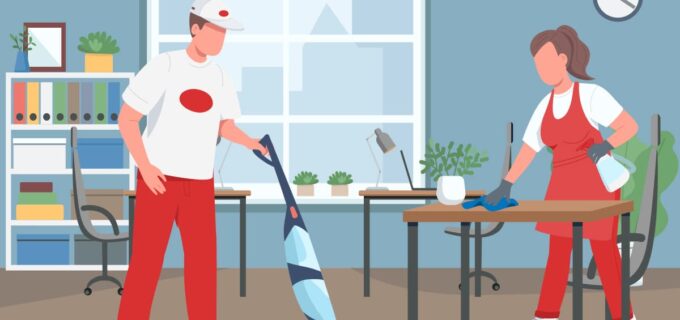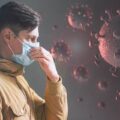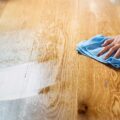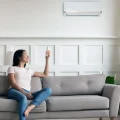In this article, we are going to re-articulate the current scientific knowledge on how the Coronavirus (Covid-19) can be transmitted from one person to another, either indirectly via objects and surfaces or more directly via physical contact.
Once again, the background research required to undertake the drafting of this article has drawn on the in-house expert knowledge of some of best cleaning and disinfection service companies in Singapore.
Contemporary Scientific Evidence on How the Coronavirus (Covid-19) is Transmitted

The Coronavirus (Covid 19) has now been shown to spread from one person to another by either direct or indirect contact with a person that is ‘Covid-19 positive’ and therefore actively shedding large numbers of potentially infectious viral particles into their surroundings.
Direct Transmission: the most prevalent mode of Covid-19 infection is by direct transmission which involves inhaling droplets that are exhaled by people when they talk, sneeze or cough. These droplets will naturally vary in size from invisible microscopic droplets to much bigger droplets clearly visible to the naked eye. The physical size and weight of the droplet determines the period of time they can remain suspended in the air and how far they can spread.
Furthermore, the smaller the droplet size, the easier it is for them to be inhaled by another person and thereby a higher risk of viral contagion via direct transmission. Some droplets may be so small that the liquid fraction quickly dries leaving only the particles of viral genetic material itself floating on air currents.
Due to the small size and weight, these infectious viral particles can stay airborne for extended periods (days rather than hours) and travel much further from their point of origin therefore posing a much greater risk of direct transmission before eventually settling. The propensity of the Covid-19 virus to remain contagious and airborne for lengthy periods is why using a face-mask and adhering to social distancing rules is vitally important.
Once the infectious viral particles have landed on an inanimate object or surface (fomites) they then continue to pose a risk via indirect transmission.
Indirect Transmission: the empirical scientific data demonstrates that a droplet infected with Covid-19 viral particles will, on average, spread around 2 metres from the point of exhalation after which time gravity will cause their descent onto a nearby surface or object. This will immediately result in that surface becoming potentially infectious to the touch and a vehicle of indirect disease transmission. However, smaller microscopic droplets will remain suspended for longer and can therefore travel further before settling. It should also be noted that in addition to being released into the area in question by exhalation, a Covid-19 positive individual will also physically shed large numbers of infectious viral particles and contaminating everything they touch.
Therefore, to summarise and conclude this section of the article, the current scientific research now clearly demonstrates that the Coronavirus (Covid-19) can be transmitted directly from one individual to another following the inhalation of infectious droplets or particles and or indirectly by infecting objects and surfaces and then transmitted to another person when they pick up the virus and subsequently transfer it by touch to their eyes, nose or mouth.
Mitigating the Risks of Coronavirus (Covid-19) Infection
The risk of infection by the Coronavirus (Covid-19) by direct transmission is exacerbated when people remain in close proximity to each other, especially in inadequately ventilated indoor spaces for prolonged periods of time. The risk of direct transmission can be significantly mitigated by social distancing, regular handwashing and hand sanitising, good respiratory hygiene (using masks and tissues with appropriate disposal) and keeping indoor spaces well ventilated.
The potential risk of indirect transmission and subsequent contagion with Coronavirus (Covid-19) from inanimate objects and surfaces depends on a number of interrelated factors, including:
- The physical characteristics of the surface and its propensity to harbour viable viral material
- The amount of viral material being shed from a positive (Covid-19) individual
- The amount of time a positive (Covid-19) individual spent in the area or setting in question
- The elapsed time since a positive (Covid-19) individual was last in the area or setting in question
The indirect infection risk from a Covid-19 contaminated environment decreases over time. It is not yet clear at what point there is zero risk from the virus, scientific research suggest that the risk of indirect viral infection is likely to be significantly reduced over a 48-hour period.
An article recently published within the New England Journal of Medicine has reported that the infectious viability of the Coronavirus (Covid-19) is contingent on several factors: first, the physical characteristics of the surface itself as well as the Relative Humidity (RH) and ambient temperature.
The results of this study indicate that the Coronavirus (Covid-19) lifespan on inanimate surfaces and objects are as follows:
- Plastics – 3 to 7 hours
- Cardboard – up to 24 hours
- Wood – up to 48 hours
- Paper – up to 4 days
- Glass – up to 4 days

At present, it is unknown how long the Coronavirus can survive on fabrics and soft furnishing, but the evidence suggests that it might extend from several hours to several days depending on the physical characteristics of the fabric in addition to the ambient conditions. Even in the absence of definitive evidence, the United States Centers for Disease Control (CDC) recommends cleaning, sanitising and disinfecting both hard and soft surfaces as the most important infection control activity that can be taken to mitigate the spread of the Covid-19 virus by indirect transmission.
Until we have attained a much better understanding of how the Covid-19 virus can spread from one person to another by cross-contamination via surfaces whether they be hard or soft, the CDC strongly recommend that they are treated in the same way as with any other highly contagious infectious disease and thoroughly clean, sanitise and disinfect inanimate objects and surfaces on a regular basis.
We will take further advice from our resident cleaning and disinfection specialists in Singapore and provide you with all the information you need to effectively clean, sanitise and disinfect inanimate objects and surfaces to substantially mitigate your risk of indirect Covid-19 infection.
General Principles of Housekeeping and Cleaning During the COVID-19 Pandemic
With the backdrop of remaining within a global pandemic, the following information has been collated to provide general housekeeping and cleaning guidance for all non-healthcare settings where neither anyone has symptoms or has been confirmed of testing positive for Coronavirus COVID-19.
Note: The more stringent guidelines for housekeeping and cleaning after a person confirmed with active COVID-19 has left the area or setting will be presented below.
Cleaning and Disinfection

The scientific evidence clearly demonstrates that regular cleaning, when carried out correctly can play a vital role in mitigating the risk of indirect COVID-19 transmission. However, before presenting the practical guidance on the appropriate cleaning protocols to follow within a period of a global viral pandemic, we should first consider the difference between cleaning and disinfection.
The Definition of Cleaning
Whilst the technical definitions contained within this article have been provided by a leading professional cleaning and disinfection company in Singapore, however it is firmly based on the US Centers for Disease Control (CDC).
‘Cleaning’ is defined by the CDC as being the removal of organic material, soil and debris from objects and surfaces and being accomplished with the combined use of water, detergents and agitation utilising cloths, brushes, mops or other cleaning apparatus. With cleaning, it is accepted that a visible difference should result in the ‘before-and-after’ appearance of the objects and surfaces in question.

Effective cleaning is a usually a prerequisite to undertaking any process of disinfection as the presence of either inorganic or organic debris or soil will diminish the efficacy of the subsequent attempts to disinfect the objects and surfaces in question. However, it should be noted that in more recent times, some combined multi-purpose cleaning and disinfecting agents that are Hydrogen Peroxide based which have been introduced into the Singaporean market which is capable of accomplishing both cleaning and disinfecting with a single product application.
Of course, it is also generally accepted that if very hot water and a detergent are used in the cleaning process, there may also be a statistically significant reduction in the viral load remaining viable on the surfaces or objects in question. However, it must be remembered that in accordance with CDC guidelines the process of ‘disinfection’ must deliver a specific microbial ‘kill rate’ to achieve this pre-defined level of hygiene.
There are also a number of general guidelines that can be followed in all circumstances to optimise the efficacy of any cleaning procedures being undertaken:
- Make the physical process of cleaning easier by reducing unnecessary clutter and removing any items that are inherently difficult to clean or prevent easy access to all the areas required to be thoroughly cleaned.
- Increase cleaning frequencies using standard, easy to use products such as detergents and bleaches.
- Cleaning frequencies should be based upon on the number of people using or passing through the space.
- Additional attention should be given to effectively cleaning all ‘high touch’ surfaces such as electronic devices, remote controls, work-surfaces, light switches, door handles and toilet fixtures and fittings.
- Regular and effective cleaning of high- touch surfaces is particularly important in toilets, bathrooms and shared kitchen facilities.
- As a minimum frequency, all ‘high touch’ should be thoroughly cleaned and wiped dry at least twice daily.
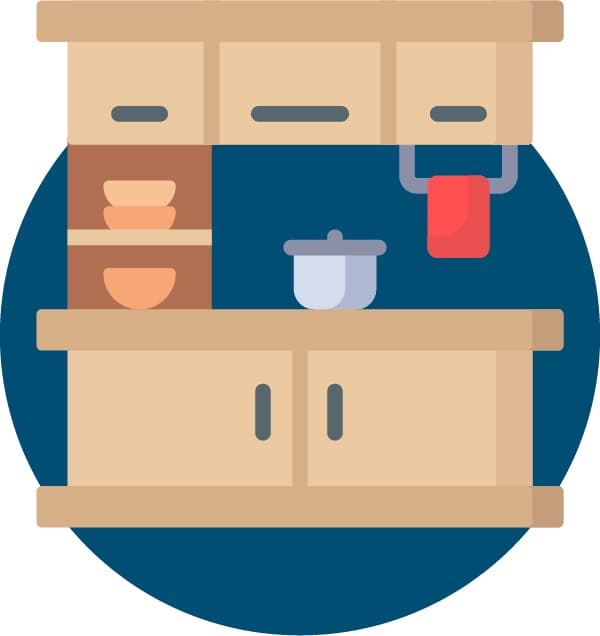
Kitchens
Although the contemporary scientific data indicates that the Coronavirus (COVID-19) is unlikely to be a food-borne disease, the usual basic principles of food-hygiene should be followed and enhanced as suggested above, and in particular, to increase the amount of handwashing and hand hygiene undertaken.

Bathrooms
Based on the current scientific research, bathroom and toilet facilities are considered to be a higher level of risk for indirect Coronavirus (COVID-19) transmission and therefore the additional guidance for these areas is as follows:
- Clean and disinfect all ‘high touch’ areas with an increased level of frequency and attention to detail.
- Ensure that adequate supplies of hand hygiene products and supplies are readily available at all times. In particular, the provision of hot running water, disinfectant hand soaps, disposable towels and tissues should be given priority.

Waste
If there has been no confirmed presence of a positive COVID-19 individual within the area or the setting in question, there is no necessity to segregate waste. Therefore, all routine general waste should be disposed of as normal. However, some additional attention should be given to ensure that all items of PPE such as hand wipes and paper towels as well as disposable face masks should be placed in conventional black bags and disposed of as usual.

Laundry
All items of laundry should be washed in accordance with the manufacturer’s directions although wherever possible, use the highest temperature wash possible within those recommendations.
Enhanced Principles of Housekeeping and Cleaning After a Person Confirmed with Active COVID-19 has been Present in that Area
The following housekeeping and cleaning protocols should be taken immediately a COVID-19 positive person has been present within a particular area or setting.
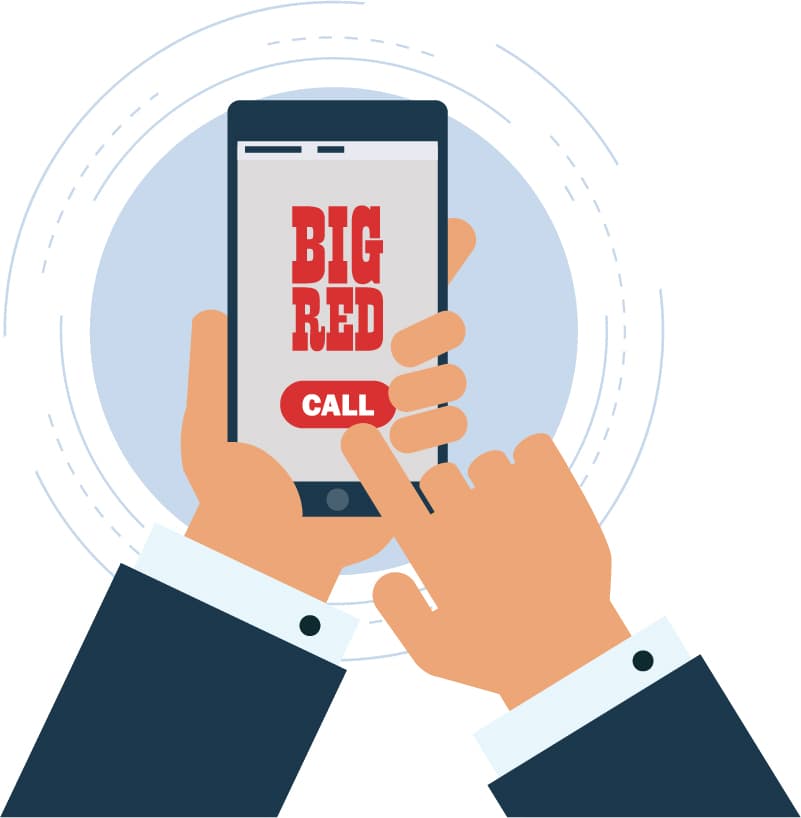
Phase One: Immediate Responses
Immediately upon discovering that a person with active COVID-19 has been present or has passed through a particular area the following responses should be actioned without delay:
- Control access to the areas in question Immediately.
- Immediately make contact with your local Health Authority and share with them all the dates, times and contact details available.
- Immediately contact a professional cleaning and disinfection company to gain technical and professional advice on how best to proceed.
Phase Two: Follow these Enhanced Principles of Housekeeping and Cleaning

Once the immediate tasks listed above in Phase One have been completed, then begin the COVID-19 post-exposure housekeeping, cleaning and disinfection procedures recommended by your chosen cleaning and disinfection company. It is important to follow the principles of infectious disease control without exception:
- Undertake regular hand washing regularly to minimise any further risk transmission.
- Wash your hands regularly with hot water and disinfectant soap for at least 20 seconds and dry carefully with paper towels or a hot-air dryer.
- If soap and hot water are unavailable (and only if your hands are not visibly dirty) you can substitute hand washing with a hand sanitiser.
- Avoid hand contact with your face, mouth, nose or eyes without handwashing or hand sanitising first.
- Always wear appropriately certified facemask and disposable gloves. After use, place the mask and gloves into a designated ‘potentially infectious’ waste bag and then wash or sanitise your hands again.
- If there is any risk of splashing from the task to be undertaken or if a risk assessment of the setting indicates that a higher level of virus may be present (for example, where someone testing positive has spent an extended period of time) then an apron and face shield should be worn in addition the mask and gloves.
- Remain vigilant and diligent at all times!
Phase Three: Cleaning and Disinfection
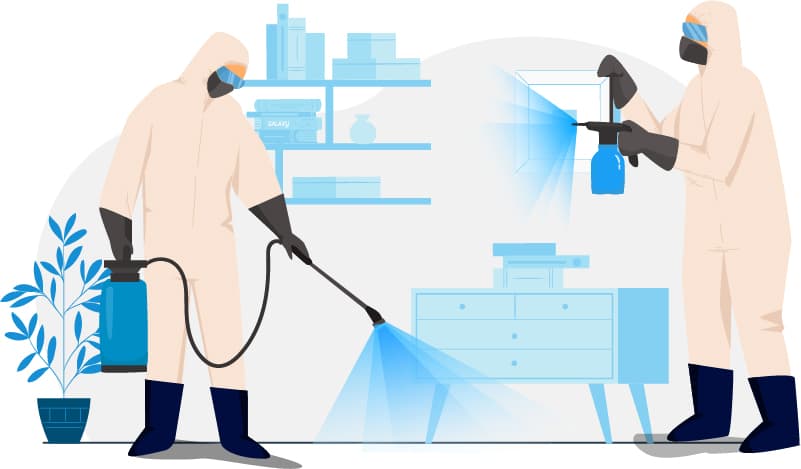
Where a symptomatic person has simply passed through and spent minimal time in an area and is not visibly contaminated with body fluids, these areas can be cleaned and sanitised thoroughly using proprietary cleaning and disinfectant products. However, any surfaces that a symptomatic or COVID-19 positive person has actually touched should be cleaned and disinfected. Where items cannot be cleaned and disinfected using traditional techniques or laundered, steam cleaning should be used instead. This should include all frequently touched area such as bathrooms and toilet fittings, door handles, telephones, grab rails in corridors and bannister rails in stairwells.
Always use disposable cloths/microfibre towels or paper towels to clean and disinfect all hard surfaces such as chairs, door handles and sanitary fittings as well as disposable mops for floors. When cleaning and disinfecting any surface, follow the ‘one site, one wipe, in one direction’ principle.
With regard to the selection of chemicals, choose one of the formulations below:
- a single formulation capable of both cleaning and disinfecting such as Hydrogen Peroxide; or
- a proprietary pre-blended detergent disinfectant solution with a dilution rate yielding at least 1,000 parts per million of available chlorine; or
- use a simple household detergent for cleaning, followed by disinfection with bleach of yielding at least 1,000 parts per million of available chlorine; or
- if an alternative disinfectant to bleach is to be used, ensure that it is diluted in accordance with the manufacturer’s instructions and is certified to be effective against enveloped viruses.
After cleaning and disinfection has been accomplished, all used disposables must be discarded and placed into specially designated ‘potentially infectious’ waste bags. All non-disposables such as uniforms or overalls should be appropriately laundered.
If the areas in question are very large and with multiple COVID-19 positive contacts involved, you should probably engage the services of a professional cleaning and disinfection services contractor to undertake the work on your behalf.
The most effective professional disinfection treatment on the market uses a nebulised Ultra Low Volume (ULV) spray of Hydrogen Peroxide solution that has been ionised using a cold plasma arc. This disinfection process is guaranteed to kill 99.9999% of all known germs. There are very few cleaning and disinfection companies that are competent and credentialed to undertake this task, so selecting the most experienced contractor available is essential.
However, no matter how efficiently we clean and disinfect contaminated surfaces, they will become potentially infectious again almost immediately after coming into contact again with a COVID-19 positive person. It is recommended to provide an additional layer of surface protection by also using a long term anti-microbial surface disinfectant. This is also a specialised procedure and is best discussed with your chosen professional cleaning and disinfection company.
Phase Four: Laundry

Whilst it is always advisable to wash items in accordance with the manufacturer’s instructions, also use the hottest choice of water setting permissible and dry items completely. Items of laundry that have been in contact with a COVID-19 positive person can still be washed with other people’s laundry, but once again at the warmest setting possible. To mitigate the risk of dispersing additional viral particles into the air, do not shake dirty laundry prior to washing.
Clean and disinfect anything that comes into contact with laundry with usual cleaning and disinfectant products, in accordance with the guidance provided above.
Phase Five: Waste Disposal
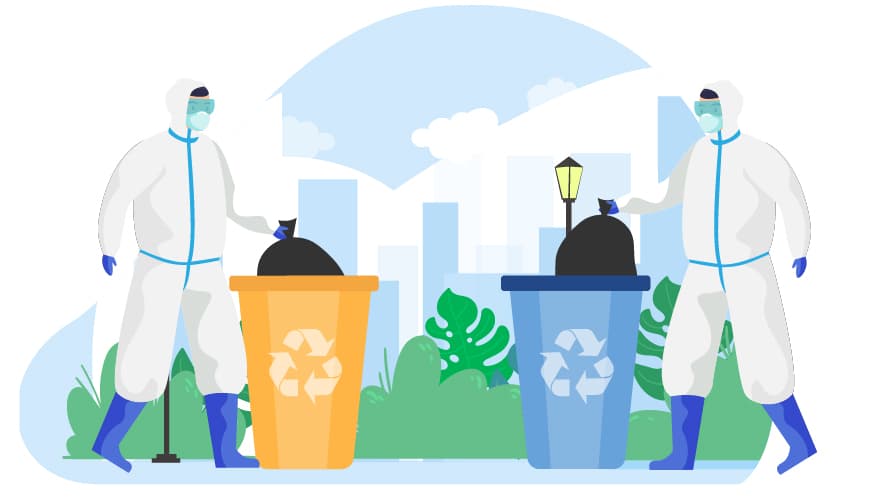
Waste emanating from COVID-19 positive people and waste from cleaning of areas where they have been (including PPE, disposable cloths and used paper towels) should be disposed of in accordance with the following protocol:
- Place the waste into a plastic rubbish bag and securely tie it when full.
- The rubbish bag should then be placed in a second bag and tied again.
- This double bagged rubbish should be designated as ‘potentially infectious waste’.
- This ‘potentially infectious waste’ should then be secured in a suitable place and stored for at least 72 hours before being disposed of with the regular waste stream.
- All areas used for storing ‘potentially infectious waste’ must also be cleaned and disinfected on a regular basis.
Related Posts
- How to Leave Coronavirus Behind When You Come Home
- Coronavirus – Protecting Your Indoor Surface
- How to Clean and Disinfect Your Home: Limiting Coronavirus Exposure
- Why Treating Air Conditioning with Antimicrobial Coatings Mitigates the Risk of Airborne Covid-19 Transmission
